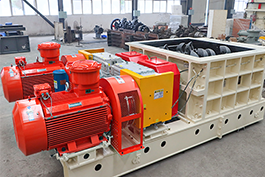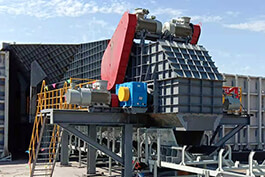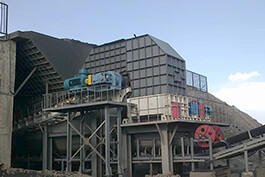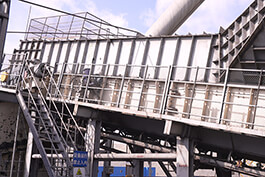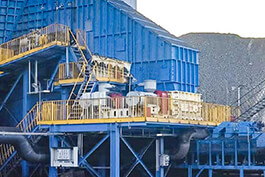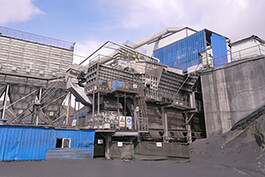Electrical System Inspection
Power Supply
Check whether the power switch is in the on position. Sometimes operators may accidentally turn off the switch, causing the mineral sizer to lose power supply. Manually check the position of the switch to ensure it is in the on position.
Check if the power indicator light is on. If the indicator light is not on, there may be an open circuit problem in the power line. Use a multimeter to measure the voltage at the power socket to confirm if there is a normal voltage output. If the voltage is abnormal, check the power supply line for damage, looseness, or blown fuses.
Check if the circuit breaker has tripped. A tripped circuit breaker may be caused by overloading of the mineral sizer. If the circuit breaker has tripped, first determine the cause and eliminate the fault before resetting the circuit breaker.
Motor Faults
Check if the motor has abnormal noise or odor. If the motor emits an abnormal humming sound or has a burnt smell, it may be due to a short circuit or grounding in the motor windings. In this case, immediately cut off the power to prevent the fault from expanding.
Use a megohmmeter to measure the insulation resistance of the motor windings. Under normal circumstances, the insulation resistance of the motor windings should be within the specified range. If the insulation resistance is too low, it indicates an insulation problem with the motor, and the motor needs to be repaired or replaced.
Check if the motor couplings are damaged or loose. The couplings connect the motor and the main shaft of the mineral sizer. If the couplings are damaged or loose, the motor's power cannot be properly transmitted to the mineral sizer, causing the equipment to stop running. Observe the appearance of the couplings to check for wear, cracks, etc. If there are any problems, replace them promptly.
Control Circuit
Check the control buttons and relays. Control buttons may have poor contact, preventing the normal transmission of control signals. Press the control button and observe if the relay operates to determine if the button is functioning properly. If the relay does not operate, it may be due to a faulty button or relay itself, and they need to be replaced.
Check the fuses in the control circuit. A blown fuse will cause an open circuit in the control circuit, preventing the mineral sizer from starting normally. Use a multimeter to check if the fuse is conducting. If the fuse is blown, replace it with a fuse of the same specification and determine the cause of the blowout.
Check the sensors and controllers. Sensors are used to detect the operating status of the equipment, such as temperature and pressure. If the sensors are faulty, it may cause the controller to misjudge, resulting in the mineral sizer stopping. Use professional testing equipment to test the sensors and ensure they are working properly. At the same time, check if the controller's parameter settings are correct and if there are any alarm messages displayed.
Transmission device inspection
Electric motor
Enclosure
Check the motor enclosure for cracks, deformations, etc. Cracks may be caused by external force impacts or long-term vibrations, which will affect the motor's protective performance, expose the internal windings, and increase the risk of short circuits and leakage; deformations may affect the motor's heat dissipation and installation stability.
Junction box
Inspect the junction box for good sealing and any signs of looseness or charring. Poor sealing will allow dust, moisture, etc. to enter, causing short circuits at the connection points; loose connections will result in poor contact, causing overheating and even sparking; charring marks indicate that overheating has occurred.
Temperature
After the motor has been running for a period of time, touch the motor enclosure by hand or use an infrared thermometer to measure the temperature of various parts of the motor. If the temperature is too high, it may be due to excessive load, poor ventilation, winding short circuits, etc. Long-term high-temperature operation will accelerate the aging of insulating materials and shorten the motor's lifespan.
Vibration
Observe the vibration of the motor during operation. Excessive vibration may be caused by loose installation, unbalanced rotor, worn bearings, etc. Vibration will affect the stability of the motor and may also cause loose connections and even damage the motor.
Sound
Listen to the sound of the motor during operation. A normally operating motor has a smooth and uniform sound. Abnormal sounds, such as shrill screeching, friction sounds, or impact sounds, may indicate bearing damage, rotor-stator friction, fan-casing contact, etc.
.jpg)
Hydraulic Coupling
Enclosure
Check the hydraulic coupling enclosure for leakage and oil stains at the sealing areas. Leakage will reduce the working medium, affecting the transmission efficiency of the hydraulic coupling and possibly polluting the surrounding environment.
Connecting Parts
Inspect the connecting bolts for looseness and the couplings for damage. Loose bolts will cause vibration and displacement during operation, affecting the stability of the transmission; damaged couplings will lead to interruption of power transmission.
Oil Quality
Observe the color and transparency of the working medium (usually oil). If the oil turns black, becomes cloudy, or has an odor, it may be due to the presence of impurities, water, or oxidation, which will affect the performance and lifespan of the hydraulic coupling.
Oil Level
Check if the oil level is within the specified range. An oil level that is too low will prevent the hydraulic coupling from operating normally and cause overheating; an oil level that is too high may lead to leakage and power loss.
Operation Status Inspection
Temperature
Monitor the working temperature of the hydraulic coupling. Excessive temperature may be caused by excessive load, poor oil quality, cooling system failure, etc. High temperatures will reduce the viscosity of the oil, affecting transmission efficiency and even damaging the seals.
Speed Ratio
Measure the speeds of the input and output shafts and calculate the speed ratio. If the speed ratio does not meet the design requirements, there may be faults inside the hydraulic coupling, such as damaged impellers or leakage in the working chamber.
Reducer
Case
Check the reducer case for cracks and deformations, especially around the mounting holes and mating surfaces. Cracks will cause oil leakage, affecting the normal lubrication of the reducer; deformations may cause poor gear meshing and increased wear.
Oil Seals and Gaskets
Inspect the oil seals and gaskets for leakage. Leakage will reduce the oil level, affecting the lubrication of gears and bearings and accelerating wear.
Self-aligning Coupling
Coupling Body
Check the surface of the coupling for cracks, wear, or deformation. Cracks will reduce the strength of the coupling and may cause it to break; wear will affect the centering performance and transmission accuracy of the coupling; deformation will prevent the coupling from working properly.
Elastic Elements
For self-aligning couplings with elastic elements, check for aging, damage, or deformation of the elastic elements. Damage to the elastic elements will affect the coupling's buffering and vibration damping performance and may cause vibration and noise during transmission.
Bolts and nuts
Check whether the connecting bolts and nuts are loose. Loose bolts can cause displacement and vibration of the coupling during operation, affecting the stability of the transmission.
Key connection
Check whether the key and keyway are worn, deformed or loose. Poor key connection can lead to unstable power transmission and even slippage.
Operation status inspection
Vibration
Observe the vibration of the coupling during operation. Excessive vibration may be caused by incorrect installation of the coupling, excessive deviation of the two shafts' concentricity, or damage to the elastic elements. Vibration can affect the normal operation of the equipment and may also cause damage to other components.
Temperature
Detect the operating temperature of the coupling. Excessively high temperature may be caused by excessive friction, poor lubrication or overload. High temperature can accelerate the wear and aging of the coupling, reducing its service life.
Mechanical system inspection
Crushing cavity
Check if there are any foreign objects blocking the crushing cavity. During the operation of the Mineral sizer, large pieces of ore, metal, and other foreign objects may enter the crushing cavity, causing the equipment to jam and stop working. Observe the feed and discharge ports of the crushing cavity to determine if there are any blockages. If there are foreign objects, the power supply should be cut off first, and then tools should be used to remove them.
Check if the crushing teeth are damaged. The crushing teeth are a key component of the Mineral sizer. After long-term use, they may become worn or broken. Inspect the wear degree of the crushing teeth. If the wear is severe, it will affect the crushing effect and even cause the equipment to fail to operate normally. In such cases, the crushing teeth need to be replaced in a timely manner.
Bearing
Check the lubrication condition of the bearings. Bearings need good lubrication to operate normally. Insufficient lubrication or deteriorated grease can cause the bearing temperature to rise, increase wear, and even lead to seizing. Check whether the grease in the bearings is sufficient and whether it has deteriorated. If the grease is insufficient, add an appropriate amount of grease; if the grease has deteriorated, clean the bearings and replace it with new grease.
Check the temperature of the bearings. Use an infrared thermometer to measure the temperature of the bearings. If the bearing temperature is too high, there may be internal faults in the bearing, such as wear or improper installation. It is necessary to stop the machine in time for inspection, identify the cause of the fault, and carry out repairs.
Check the vibration of the bearings. Touch the bearing housing with your hand to feel the vibration of the bearings. If the vibration of the bearings is abnormal, it may be due to insufficient installation accuracy or problems with the bearings themselves. Check whether the bearings are installed correctly. If necessary, reinstall the bearings.
Lubrication system inspection
Oil quality
Check the quality of the lubricating oil, including color, viscosity, and impurity content. Poor oil quality will affect the lubrication effect and increase the wear of gears and bearings.
Oil quantity
Ensure that the oil level of the lubricating oil is within the specified range. Insufficient oil will lead to poor lubrication, overheating, and wear; excessive oil will increase the stirring resistance and consume additional power.
Gear and bearing inspection
Sound
Listen to the sound of the reducer during operation. If there are abnormal noises, such as sharp whistling or heavy knocking sounds, it may be due to gear wear, tooth surface adhesion, or bearing damage.
Vibration
Detect the vibration of the reducer. Excessive vibration may be caused by poor gear meshing, excessive bearing clearance, or deviation in the concentricity of the shaft. Vibration will accelerate the wear of components and reduce the reliability of the reducer.
Temperature check
Monitor the operating temperature of the reducer. Excessive temperature may be caused by poor lubrication, excessive load, or poor heat dissipation. Long-term high-temperature operation will reduce the performance of the lubricating oil and accelerate the wear of components.
Conclusion
The reasons for the shutdown of the Mineral sizer are multi-faceted. If it suddenly stops and the cause cannot be identified, you can try to gradually troubleshoot according to the above aspects such as the electrical system, transmission device, mechanical system, and lubrication system, and then find the real cause of the Mineral sizer's shutdown and solve it effectively.


.jpg)
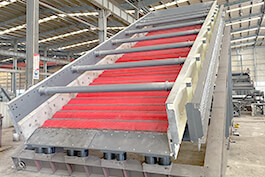
.jpg)
